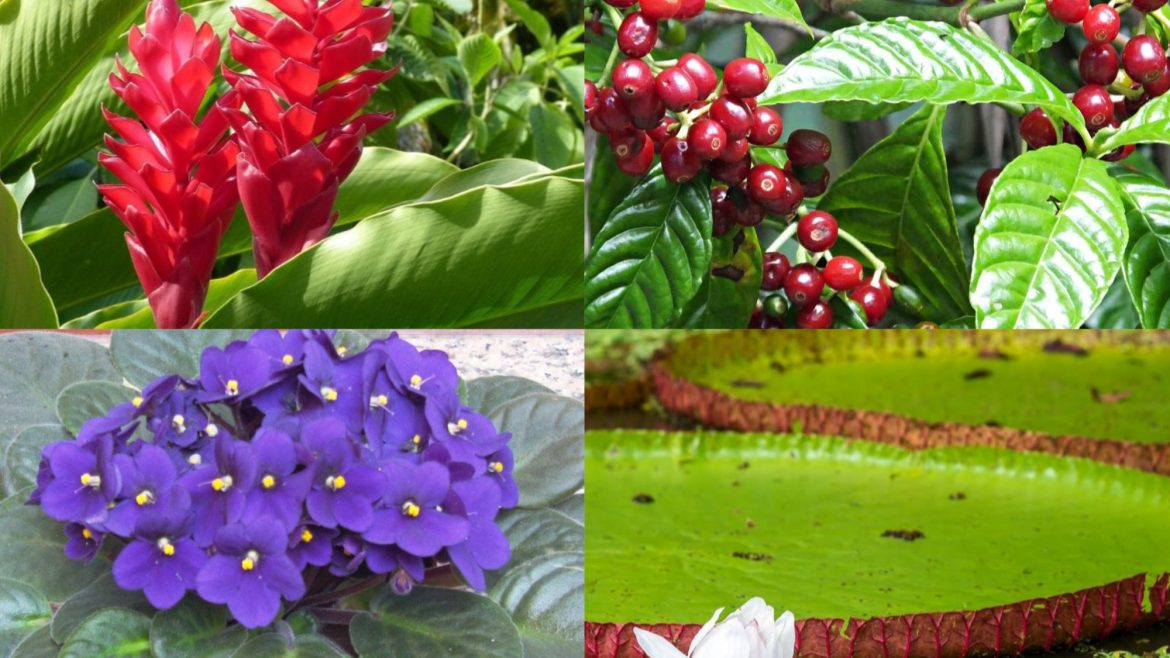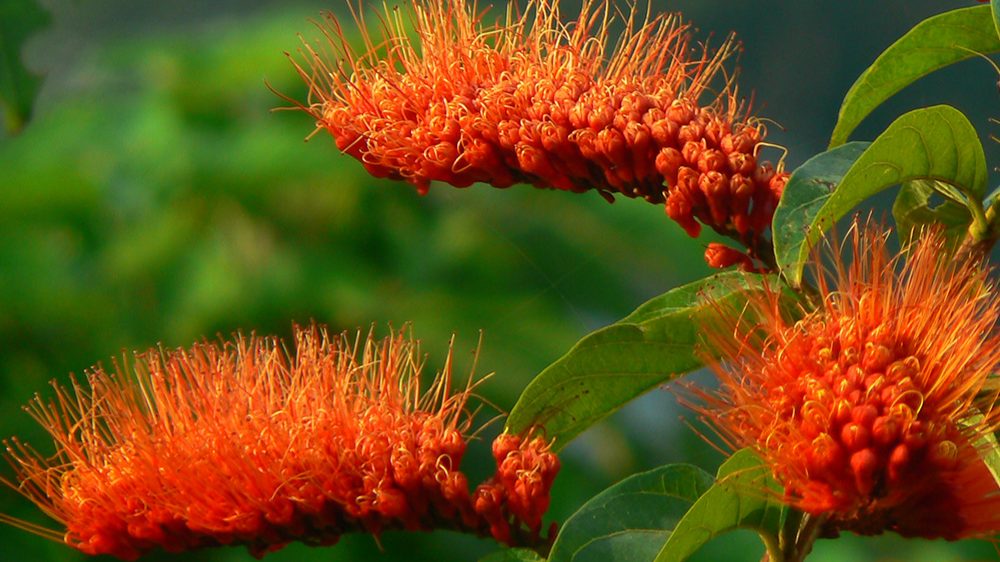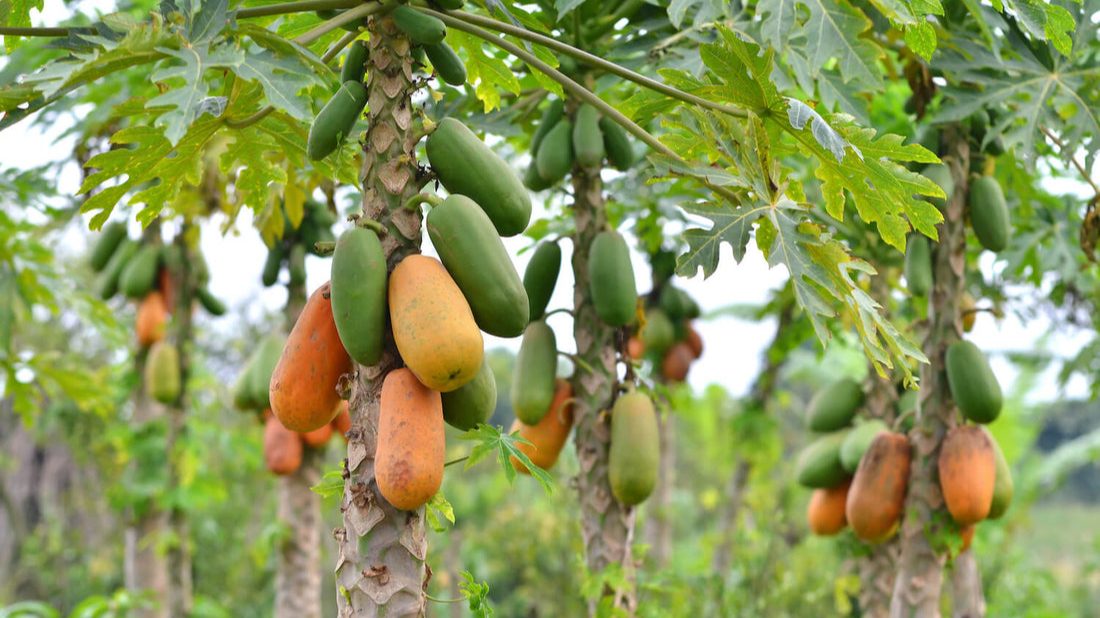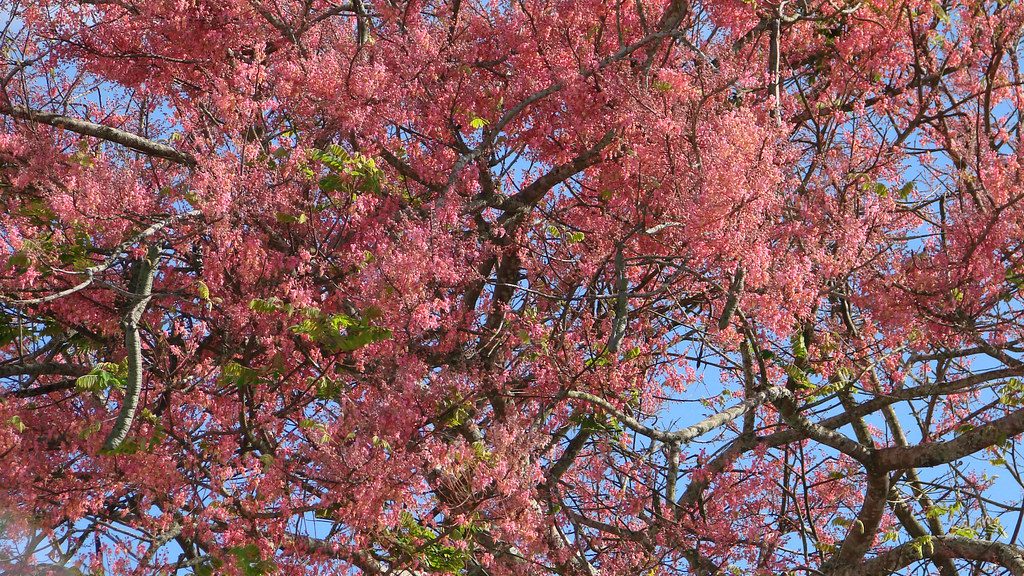Ever noticed how a single leaf can tell a story? In the dense, humid world of rainforests, countless green tales unfold daily.
Our planet’s rainforests hide plants that heal, feed, and even protect. Some look strange, others beautiful – but each plays a key role in nature’s plan.
This blog will show you some remarkable rainforest plants worth knowing. Not just because they’re pretty, but because they matter – to medicine, to wildlife, and maybe even to your future.
From flowers that glow to leaves that “talk,” these plants might surprise you. Some have helped people for centuries, while others hold secrets we’re just beginning to understand.
The rainforest is nature’s ultimate innovation hub, endlessly designing and perfecting new species. Many familiar fruits medicines trace their origins to these rich, diverse ecosystems.
Ready to meet these green neighbors? Let’s walk through the rainforest together and see what we find.
Why are Rainforest Plants Important?
Rainforest plants aren’t just pretty to look at – they’re essential to life as we know it.
Rainforest plants are the backbone of Earth’s most productive ecosystems. These green powerhouses clean our air by absorbing carbon dioxide and releasing oxygen, helping regulate global climate patterns.
They’re nature’s pharmacy – one in four modern medicines contains rainforest-derived ingredients, with countless potential treatments still waiting to be discovered.
Our kitchens would be much emptier without them. Chocolate, vanilla, cinnamon, and coffee all began as rainforest plants, not to mention the genetic diversity they provide to strengthen our crops.
These plants create homes for roughly half of all animal species, building intricate habitats from forest floor to canopy.
Their root systems filter water, prevent erosion, and maintain river flows that affect regions far beyond forest boundaries.
Perhaps most valuable is what we’ve yet to learn – each plant represents millions of years of evolutionary problem-solving, offering solutions to challenges we’re only beginning to understand.
List of Rainforest Plants
1. Heliconia
Heliconias are tropical plants with large, banana-like leaves and vibrant, brightly colored flowers that resemble lobster claws or bird beaks. Their colorful bracts range from red, orange, and yellow hues, creating a striking visual in the rainforest.
Scientific Name: Heliconia spp.
Where It Is Found: Tropical rainforests of Central and South America.
Medicinal Uses: Used in traditional medicine for treating fever and as a remedy for wounds.
Fun Facts:
- Hummingbirds are key pollinators for Heliconia.
- The plant is often called “lobster claws” due to the shape of its flowers.
2. Cattleya Orchid
Cattleya orchids are known for their large, colorful, and fragrant flowers with petal structures that are often purple, pink, or white with a yellow throat. The flowers have waxy, smooth textures and are often symmetrically arranged.
Scientific Name: Cattleya spp.
Where It Is Found: Found in tropical rainforests of South and Central America.
Medicinal Uses: Used in folk medicine for treating respiratory issues and digestive disorders.
Fun Facts:
- Known as the “queen of orchids” due to their stunning beauty.
- The flower’s fragrance is used in perfumes.
3. Bromeliads
Bromeliads are colorful, rosette-shaped plants with spiky, leathery leaves that often store water in their centers, providing a habitat for small animals. They come in bright shades like red, orange, and purple.
Scientific Name: Bromeliaceae
Where It Is Found: Tropical rainforests in Central and South America.
Medicinal Uses: Some species are used to treat inflammation and digestive issues.
Fun Facts:
- Bromeliads help to provide water for small animals like frogs and insects.
- The pineapple plant is a type of bromeliad.
4. Giant Water Lily
The giant water lily has massive, round leaves that can span up to 10 feet in diameter, with thick, leathery textures and sharp, spiny undersides. Its large, fragrant white and pink flowers bloom overnight.
Scientific Name: Victoria amazonica
Where It Is Found: Found in the Amazon River Basin in South America.
Medicinal Uses: Used in traditional medicine for its potential to treat skin conditions.
Fun Facts:
- The leaves of the water lily can support small animals, including insects.
- The flower only blooms for two days, changing color from white to pink.
5. Achiote
Achiote plants produce spiky fruit pods that contain small, red seeds which are used to make annatto, a natural food coloring. The plant has large, green, soft leaves and striking pink flowers.
Scientific Name: Bixa orellana
Where It Is Found: Native to tropical rainforests in Central and South America.
Medicinal Uses: Seeds are used to treat digestive problems and reduce inflammation.
Fun Facts:
- The red dye from the seeds is commonly used in food, cosmetics, and textiles.
- Achiote is often called the “lipstick tree” because of its rich, red color.
6. Rafflesia Arnoldii
Rafflesia Arnoldii is known for producing the world’s largest single flower, with a distinctive reddish-brown color and a foul odor resembling rotting flesh. The flower’s petals are leathery and speckled with white spots.
Scientific Name: Rafflesia arnoldii
Where It Is Found: Found in the rainforests of Southeast Asia, particularly in Indonesia.
Medicinal Uses: Some traditional uses for the flower include treatments for infections, though it is rarely used medicinally.
Fun Facts:
- It is also known as the “corpse flower” due to its pungent smell.
- The flower can grow up to 3 feet in diameter.
7. Rubber Tree
The rubber tree is a large tree with smooth, dark green leaves and a white latex sap that is tapped for rubber production. It has a distinct bark and slender branches that are often high up in the rainforest canopy.
Scientific Name: Hevea brasiliensis
Where It Is Found: Native to the Amazon rainforest in South America.
Medicinal Uses: Latex is used in wound dressings and other medical applications.
Fun Facts:
- The rubber tree is the primary source of natural rubber.
- It has been widely cultivated in Southeast Asia since the 19th century.
8. Passionflower
Passionflower vines are known for their unique, intricate blossoms that have a circular shape with white and purple petals. The fruit is round and orange, and the vine itself is dense with thick, glossy green leaves.
Scientific Name: Passiflora edulis
Where It Is Found: Native to tropical rainforests in South America.
Medicinal Uses: The fruit is used to treat anxiety, insomnia, and digestive problems.
Fun Facts:
- Passionflower vines are often grown for their edible fruit, passionfruit.
- The flowers are known for their striking, unique appearance.
9. Coffee Plant
The coffee plant has glossy, dark green leaves and produces small white flowers that have a strong fragrance. The fruit ripens into red or purple cherries that contain coffee beans.
Scientific Name: Coffea arabica
Where It Is Found: Native to the highland regions of tropical Africa and found in rainforests at higher altitudes.
Medicinal Uses: The beans are used in various cultures for their stimulant effects and potential health benefits.
Fun Facts:
- Coffee is one of the most traded commodities in the world.
- The seeds (coffee beans) contain caffeine, a natural stimulant.
10. Water Lettuce
Water lettuce has light-green, soft, and velvety rosettes of leaves that float on the water’s surface. The leaves have a feathery texture, and the plant spreads rapidly across aquatic environments.
Scientific Name: Pistia stratiotes
Where It Is Found: Found in the slow-moving rivers and ponds of tropical rainforests worldwide.
Medicinal Uses: Used in folk medicine for treating skin diseases and calming inflammation.
Fun Facts:
- It helps improve water quality by absorbing excess nutrients and pollutants.
- Water lettuce provides shelter for small aquatic creatures like fish and insects.
11. Monkey Brush Vine
The Monkey Brush Vine is a climbing vine with long, tubular, bright red or orange flowers that resemble a monkey’s brush. Its flowers are densely packed and hang in clusters, attracting hummingbirds.
Scientific Name: Callistemon citrinus
Where It Is Found: Found in the tropical rainforests of Australia.
Medicinal Uses: The plant is used in traditional medicine for treating colds and respiratory issues.
Fun Facts:
- The flowers are shaped like bottlebrushes, hence the name.
- It’s often used in ornamental landscaping due to its striking appearance.
12. Sundew
Sundews are small carnivorous plants with rosettes of long, sticky, hair-like tentacles that glisten in the light, trapping insects that land on them. The tentacles are covered in digestive glands that break down prey.
Scientific Name: Drosera spp.
Where It Is Found: Found in tropical and subtropical rainforests, especially in Australia, Southeast Asia, and the Americas.
Medicinal Uses: Some species are used in folk medicine to treat coughs, bronchitis, and asthma.
Fun Facts:
- Sundews use a “sticky trap” to catch insects, which they digest for nutrients.
- The plant gets its name from the droplets on its tentacles, which resemble dew.
13. Strangler Fig
The Strangler Fig is a large tree that begins as an epiphyte, growing on other trees and sending roots down to the ground, eventually enveloping and “strangling” its host tree. It has thick, dark green leaves and produces small figs.
Scientific Name: Ficus spp.
Where It Is Found: Found in tropical rainforests of Southeast Asia, Central America, and Africa.
Medicinal Uses: The leaves and bark are used in traditional medicine to treat wounds, infections, and gastrointestinal issues.
Fun Facts:
- Strangler figs are known for their unusual growth habit, strangling their host tree.
- The figs produced by the tree are important food sources for many animals, including birds and monkeys.
14. Cocoa Tree
The Cocoa Tree has large, glossy green leaves and produces small, white flowers on the trunk and branches. Its fruit, the cocoa pod, contains beans that are the source of chocolate, varying in color from yellow to red.
Scientific Name: Theobroma cacao
Where It Is Found: Native to the Amazon Basin and found in tropical rainforests of Central and South America.
Medicinal Uses: Cocoa has antioxidant properties and is used in various forms for improving heart health and mood.
Fun Facts:
- Cocoa is the main ingredient in chocolate, one of the world’s most beloved treats.
- The trees are often grown in the shade of taller rainforest trees to protect them from direct sunlight.
15. Red Ginger
Red Ginger is a tropical plant with narrow, glossy green leaves and tall, upright spikes of bright red flowers. The flowers are tubular and grow in dense clusters, standing out against the surrounding foliage.
Scientific Name: Alpinia purpurata
Where It Is Found: Native to Southeast Asia and found in tropical rainforests of the Pacific Islands.
Medicinal Uses: It is used in traditional medicine for its anti-inflammatory properties and to alleviate nausea.
Fun Facts:
- Red Ginger is often used as an ornamental plant due to its striking flowers.
- The plant’s rhizomes are used in some culinary dishes, especially in Southeast Asia.
16. African Violet
The African Violet is a small, flowering plant with soft, velvety, rounded leaves and clusters of vibrant purple, blue, or white flowers. It thrives in humid environments and is often found growing near other tropical plants.
Scientific Name: Saintpaulia spp.
Where It Is Found: Native to tropical rainforests of East Africa.
Medicinal Uses: The plant is sometimes used for soothing ailments like colds and headaches, although its medicinal use is limited.
Fun Facts:
- African violets are popular as houseplants due to their small size and easy care.
- The plant’s flowers come in a variety of colors, including purple, pink, and white.
17. Bamboo
Bamboo is a fast-growing grass with tall, slender stems that can reach towering heights. The plant has a woody texture and grows in dense clumps with narrow, lance-shaped leaves.
Scientific Name: Bambusoideae
Where It Is Found: Found in tropical and subtropical rainforests of Asia, South America, and Africa.
Medicinal Uses: Bamboo shoots are used in traditional medicine for digestive issues and as a diuretic.
Fun Facts:
- Some species of bamboo can grow up to 35 inches per day, making it one of the fastest-growing plants.
- Bamboo is used in a variety of products, including furniture, paper, and flooring.
18. Fishtail Palm
The Fishtail Palm has long, slender trunks and large, glossy, pinnate leaves that resemble a fishtail shape. The plant produces small, yellow flowers that grow in clusters.
Scientific Name: Caryota urens
Where It Is Found: Found in tropical rainforests of Southeast Asia, including India, Malaysia, and Indonesia.
Medicinal Uses: The sap of the Fishtail Palm is used in traditional medicine to treat gastrointestinal disorders and as a mild laxative.
Fun Facts:
- The plant is often used in landscaping and as an ornamental plant due to its unique leaf shape.
- The Fishtail Palm is a source of “toddy,” a fermented drink made from its sap.
19. Papaya Tree
The Papaya Tree has a single, tall trunk with large, deeply lobed leaves at the top. Its fruit is large, oblong, and orange, with sweet, juicy flesh inside.
Scientific Name: Carica papaya
Where It Is Found: Native to tropical rainforests of Central America, now widely grown in tropical regions worldwide.
Medicinal Uses: Papaya has digestive enzymes that aid in digestion and is used in traditional medicine to treat skin wounds and infections.
Fun Facts:
- Papayas are often used in smoothies, salads, and desserts due to their sweet, tropical flavor.
- The plant’s enzymes, especially papain, are used in meat tenderizers.
20. Soursop Tree
The Soursop Tree has broad, glossy leaves and produces large, spiky, green fruits that are fibrous on the inside. The tree also has fragrant white flowers that bloom before the fruit appears.
Scientific Name: Annona muricata
Where It Is Found: Native to the rainforests of Central and South America, and now grown in tropical regions worldwide.
Medicinal Uses: Soursop is used in traditional medicine to treat a variety of ailments, including fever, inflammation, and digestive issues.
Fun Facts:
- The fruit of the soursop tree has a sweet, tangy flavor, and is often used in drinks and desserts.
- Soursop leaves are used in some cultures for making teas that are believed to have medicinal benefits.
21. Corpse Flower
The Corpse Flower is known for its massive, reddish-brown flower that emits a foul odor, similar to rotting flesh. The flower has large, leathery petals with a distinctive spadix in the center.
Scientific Name: Amorphophallus titanum
Where It Is Found: Found in the rainforests of Sumatra, Indonesia.
Medicinal Uses: While rarely used, the plant has been studied for potential medicinal properties, including antimicrobial effects.
Fun Facts:
- The Corpse Flower can take years to bloom, with some plants only flowering once every 7-10 years.
- It is one of the largest flowers in the world, reaching up to 10 feet in height.
22. Tangarana Tree
The Tangarana Tree is a large evergreen tree with wide, glossy, dark green leaves and clusters of yellow, fragrant flowers that bloom in the dry season. It produces large, brown fruit that contains seeds used for propagation.
Scientific Name: Tachigali melinonii
Where It Is Found: Found in the rainforests of the Amazon Basin in South America.
Medicinal Uses: The bark and leaves of the Tangarana Tree are used in traditional medicine to treat fevers and digestive issues.
Fun Facts:
- The tree is known for its ability to regenerate quickly after deforestation.
- Tangarana trees are important for restoring soil quality in degraded rainforests.
23. Pink Shower Tree
Pink Shower Tree is a large tree with broad, green leaves and bright, showy clusters of pink or purple flowers. Its large seed pods grow in long, cylindrical shapes, and the flowers attract various pollinators.
Scientific Name: Cassia grandis
Where It Is Found: Native to the rainforests of Central America and parts of South America.
Medicinal Uses: The seeds and leaves of the Cassia Grandis tree are used in traditional medicine to treat headaches, skin conditions, and digestive problems.
Fun Facts:
- The tree is often used in urban landscaping due to its vibrant flowers and shade.
- The Cassia Grandis is also known as the “Pink Shower” tree because of its bright, cascading flowers.
24. Lobster Claw
Lobster Claw is a tropical plant known for its unique, brightly colored flowers that resemble lobster claws. The flowers have red, orange, or yellow bracts, making them a striking addition to the rainforest.
Scientific Name: Heliconia rostrata
Where It Is Found: Found in the rainforests of Central and South America.
Medicinal Uses: The plant is used in some traditional medicines for treating wounds and fever.
Fun Facts:
- The plant is often called “lobster claw” due to its flower’s resemblance to a lobster’s claw.
- Hummingbirds are the primary pollinators of the Lobster Claw plant.
25. Bougainvillea
Bougainvillea is a vibrant, climbing shrub with thorny branches and colorful bracts in shades of purple, pink, red, or white. Its paper-like flowers are surrounded by bright bracts that give it a showy, tropical appearance.
Scientific Name: Bougainvillea spp.
Where It Is Found: Native to South America, commonly found in tropical and subtropical regions worldwide.
Medicinal Uses: Bougainvillea has been used in traditional medicine for its purported antibacterial properties and to treat fever and inflammation.
Fun Facts:
- Bougainvillea is known for its hardy nature, thriving in a variety of soil types.
- The colorful bracts are often mistaken for the plant’s flowers, but the true flowers are small and white.
26. Vanilla Orchid
The Vanilla Orchid is a climbing plant with long, slender stems and large, waxy, pale yellow to white flowers. Its distinctive, fragrant blossoms are followed by long, green pods that turn into vanilla beans as they ripen.
Scientific Name: Vanilla planifolia
Where It Is Found: Native to the tropical rainforests of Mexico and now grown in other tropical regions worldwide.
Medicinal Uses: Vanilla is used for its calming properties and is sometimes used in aromatherapy to reduce stress and anxiety.
Fun Facts:
- Vanilla is the second most expensive spice in the world, after saffron.
- The vanilla orchid is pollinated by specific species of bees or hummingbirds, making it a rare and delicate process.
27. Silky Oak
Silky Oak is a large tree with feathery, fern-like leaves and clusters of bright yellow to orange, brush-like flowers that attract pollinators. The tree’s bark is smooth, and it produces woody seed pods.
Scientific Name: Grevillea robusta
Where It Is Found: Native to the rainforests of Eastern Australia.
Medicinal Uses: The bark and leaves are used in traditional medicine for their antimicrobial and anti-inflammatory properties.
Fun Facts:
- Silky Oak is prized for its durable timber, often used in furniture-making.
- The tree is known for its vibrant flowers that bloom in clusters, creating a stunning display.
28. Pitcher Plant
The Pitcher Plant is a carnivorous plant with tubular, pitcher-shaped leaves that trap insects. These leaves have a slippery surface that causes prey to fall into the water-filled cavity where they are digested.
Scientific Name: Nepenthes spp.
Where It Is Found: Found in tropical rainforests of Southeast Asia, Australia, and some parts of Madagascar.
Medicinal Uses: Some species of Pitcher Plant are used in traditional medicine for treating stomach ailments and as a digestive aid.
Fun Facts:
- The plant’s “pitcher” structure is designed to lure and trap insects with its sweet nectar.
- Some species of Pitcher Plants can grow leaves that are several feet long, making them some of the largest carnivorous plants.
29. Mahogany
Mahogany is a large tree with broad, dark green leaves and small, fragrant flowers that bloom in clusters. The tree produces large, reddish-brown pods containing seeds, and its wood is prized for its rich, reddish hue and durability.
Scientific Name: Swietenia macrophylla
Where It Is Found: Native to the tropical rainforests of Central and South America.
Medicinal Uses: Mahogany bark has been used in traditional medicine to treat fevers and infections. The wood has also been used in the creation of medicinal tools.
Fun Facts:
- Mahogany wood is highly valued for furniture, cabinetry, and decorative items due to its strength and color.
- The tree can grow up to 150 feet tall, making it one of the tallest in the rainforest.
30. Balsa Tree
The Balsa Tree is a fast-growing tree with broad, oval-shaped leaves and small clusters of white or yellow flowers. The tree’s lightweight wood is soft and porous, making it perfect for a variety of uses.
Scientific Name: Ochroma pyramidale
Where It Is Found: Native to the tropical rainforests of Central and South America.
Medicinal Uses: The leaves and bark have been used in traditional medicine to treat wounds, infections, and inflammations.
Fun Facts:
- Balsa wood is known for being the lightest commercially available wood in the world.
- It is commonly used in the production of model airplanes and insulation materials.
31. Ironwood Tree
The Ironwood Tree is a large, slow-growing tree with tough, dense wood and dark green, leathery leaves. It produces small, inconspicuous flowers, and its bark is rough and thick, offering protection against harsh environmental conditions.
Scientific Name: Olneya tesota
Where It Is Found: Found in the Sonoran Desert and tropical rainforests of the Southwestern United States and Mexico.
Medicinal Uses: Ironwood has been used in traditional medicine to treat pain and inflammation, and its extracts are sometimes used as a remedy for fever and arthritis.
Fun Facts:
- The tree’s dense wood is one of the hardest and heaviest in North America, often used in crafting durable tools and furniture.
- Ironwood trees are known for their resilience and can survive in extremely dry and harsh conditions, thriving in desert areas as well as rainforests.
Wrapping Up!
So there you have it – these remarkable plants that call the rainforest home. Each one tells a story of survival, usefulness, and beauty in its own way.
These green neighbors aren’t just interesting to look at. They clean our air, heal our bodies, feed our families, and teach us lessons about living in balance with nature.
The next time you sip chocolate, take medicine, or simply breathe deep, remember these rainforest plants played a part in making it possible.
Our world needs these plants, just as they need safe homes to grow in. By learning about them, we take the first step toward protecting them.
What rainforest plant surprised you most? Which one would you like to see in person someday? The green world is full of wonders waiting for curious minds like yours.
Until next time, watch for plant magic everywhere – from lush rainforests to your own backyard.































